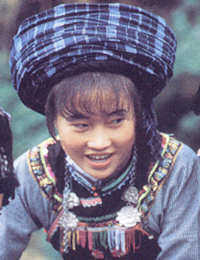 The Bouyei (also Buyi) people, with a population of 2,545,059 (by 1990), are mainly scattered in the Bouyei and Miao autonomous prefectures in south Guizhou and Anshun. Some live in the Miao and Dong autonomous prefecture in southeastern Guizhou and around Guiyang while there is also a sparse distribution in the Yunnan, Sichuan, Guangxi and other provinces.
The Bouyei (also Buyi) people, with a population of 2,545,059 (by 1990), are mainly scattered in the Bouyei and Miao autonomous prefectures in south Guizhou and Anshun. Some live in the Miao and Dong autonomous prefecture in southeastern Guizhou and around Guiyang while there is also a sparse distribution in the Yunnan, Sichuan, Guangxi and other provinces.
The Bouyei people have their own language, which belongs to the Zhuang-Dai branch of the Zhuang-Dong Austronesian of the Chinese-Tibetan Phylum. In the past, the Bouyeis had no written language of their own, and used Han characters instead. After 1949, the government helped formulate a Bouyei writing system based on the Latin alphabet.
The Bouyei people were the aboriginal dwellers on the southeast Yunnan-Guizhiou Plateau. Studies of the language, names and geographical distribution of the Bouyeis indicate that they have a common ancestry with the Zhuangs -- both originated from one branch of the ancient Baiyue people. The similarity between the modern Zhuang and Bouyei languages and the ancient Louyue tongue is a strong indication of the origin of the Bouyeis. In addition, many habits and customs of the Yues still prevail among the Bouyeis. According to historical records, the Bouyeis always referred to themselves as "Buyi" or Buyue". With the founding of the PRC in 1949, following consultation with the ethnic group, it agreed upon the official name of Bouyei ethnic minority.
The Bouyeis are mainly engaged in agriculture. They are skilled in arts and crafts. Their colorful and beautifully patterned batik dates far back to ancient times. Now, batik has become one of their best-selling handicrafts, popular both on domestic and foreign markets.
In the past, the Bouyeis believed in spirits and worshipped ancestors, although many living near missionary outposts were converted to Christianity and Catholicism. In general, they have the same festivals as the Hans, such as the Spring Festival, the Dragon Boat Festival and the Mid-autumn Festival. On April 8 and June 6, however, they celebrate their own festivals in commemoration of the leaders of ancient uprisings and their ancestors. On Ox King Festival special cakes and glutinous rice dyed in five different colors are made and offered to ancestors. After the ceremony, half of these offerings are given to their cattle, which are also granted a day of rest as a reward for their hard work.
The Bouyei region is on the Yunnan-Guizhou Plateau, which slopes from an altitude of 1,000 meters in the north to 400 meters in the south. The Miaoling Mountains stretch across the plateau, forming part of its striking landscape. The famous Huangguoshu Falls cascade down more than 60 meters near the Yunnan-Guizhou highway in Zhenning Bouyei-Miao Autonomous County. The thunder of water can be heard several kilometers away, and mists from the falls contribute to a magnificent view.
